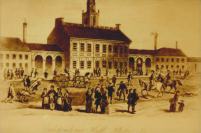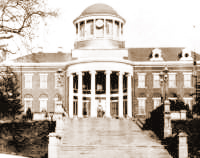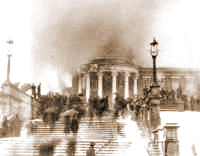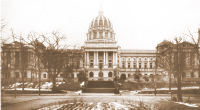The History of Pennsylvania's Early CapitolsFrom 1681 until 1729, Pennsylvania's colonial legislature would meet wherever it could find the space, ranging from local taverns, private residences, and town halls to other meeting places. However, by the close of the third decade of the 18th century, population growth made this option unrealistic. In 1729, the Pennsylvania Assembly voted to appropriate money to build a state house. The house was finished and occupied in 1753 and became famous as the colonies moved toward revolution. It was the place where both the Declaration of Independence and the Constitution of the new nation were debated and signed. From 1790 to 1800, when Philadelphia was the nation's Capital, the state and national legislatures both met in the building. By 1799, the State Assembly, citing reasons ranging from disease to population growth, moved westward to Lancaster, and a year later Congress convened in Washington, D.C. The Capitol's existence in Lancaster was short lived. In 1785, John Harris, Jr. donated four acres of land along the Susquehanna and recommended this as the site for a new state capitol. In 1812, the Assembly used Harris' donated land, combined with more than ten acres purchased from William Maclay, to build two state office buildings. Local architect Stephen Hills was chosen to construct the buildings, and in 1812, the Legislature moved to Harrisburg. Until 1822, they met in the old Dauphin County Courthouse, which was modified for the state to use. Stephen Hills began assembling materials to build the Capitol in 1816, although he was not officially chosen as architect until 1819. Actual construction began on April 19, 1819, with the cornerstone for the new building put in place in May. Construction progressed rapidly, and by December 1821, the new building was ready for occupancy. The total cost for the building, including furnishings, was $158,000. On January 2, 1822, Hills and 80 workmen formed a procession leading the legislature and dignitaries to the new building and into the House Chamber for the dedication ceremony. During the course of its seventy-five-year existence, the Hills Capitol saw several additions and alterations. But on February 2, 1897, in the middle of a snowstorm, hundreds of Harrisburg residents stood helpless as the Capitol burned out of control. The Legislature, which was in session at the time, was forced to evacuate and reconvene in the Grace Methodist Episcopal Church. It was uncertain whether Harrisburg would remain the capital because measures were taken to try to move the seat of government back to Philadelphia. These were later postponed when the Legislature voted to tear down the remaining brick structure of the burned-out Hills Capitol and replace it with a larger and more modern structure, appropriate for a state that was then an industrial giant. To do so, they appropriated $500,000, held a design competition, and afterwards chose Henry Ives Cobb to create their new building. Cobb's well-intended ideas and design for the new, grand building looked good on paper. However, part way through the project, the Legislature realized there were not enough funds to complete the building according to the plans they had approved. They instructed Cobb to provide only the shell of the building and make it functional. Although never completed to the full scale that the architect intended, the Cobb Capitol served an important purpose in Pennsylvania history by allowing the seat of government to remain in Harrisburg. Dissatisfied with the end result, in 1901, the Legislature again issued a design competition to complete the existing Cobb Capitol with funds that were now accruing through recovered debts owed to the State. A young aspiring Philadelphia architect named Joseph M. Huston won the competition. From the beginning, Huston was determined to make his building one of the most brilliant architectural and artistic public governmental seats in America. He modeled the building in the Renaissance Revival style, studying and imitating many of the great buildings in Europe such as the Paris Opera House and St. Peter's Basilica in Rome. Construction began in 1902 and lasted until October of 1906. A crowd of more than 50,000 people came on special Pennsylvania Railroad excursion trains to Harrisburg to hear President Theodore Roosevelt dedicate the building with the words, "It is the handsomest State Capitol I have ever seen." |
INDEPENDENCE HALL
LANCASTER COUNTY COURTHOUSE
HILLS CAPITOL
HILLS CAPITOL FIRE
COBB CAPITOL
HUSTON CAPITOL |





